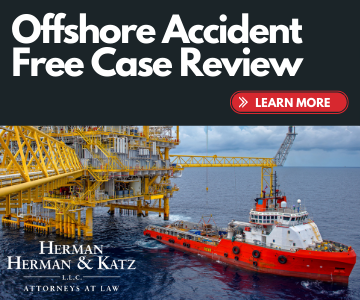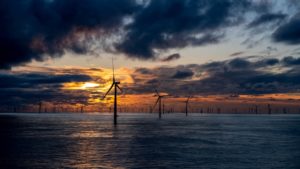
Oil and gas production has always been a vital industry in the Gulf of Mexico – and Louisiana’s workers are the ones who risk their lives to keep it going. Working on big rigs in the middle of the Gulf is fraught with occupational hazards, including lack of training and supervision, risk of being electrocuted or crushed on deck, risk of falling overboard, and fires or explosions.
Wind power is now the number one source of renewable energy in the U.S. Last fall, Gov. John Bel Edwards announced his new initiative to make Louisiana a leader in harnessing wind power and eliminatinge statewide greenhouse gas emissions by 2050.
Many oil and gas workers are open to transferring to wind farms, which will require many of the same skills. They’re an obvious choice for the state’s once-largest industry, which now employs just 1.5 percent of its workforce.
While they are certainly better for the environment and the job market, it remains to be seen how wind farms may increase or decrease offshore accidents.
What Is a Wind Farm?
A wind farm is a cluster of several wind turbines on or offshore. Wind turbines use the wind to create electricity, rather than relying on electricity to make wind. Naturally occurring wind – a form of solar energy – turns the turbine’s propeller-like blades around a rotor, which spins a generator that creates electricity. A single small turbine can produce enough electricity to power a standard home. There are currently almost 60,000 wind turbines in the U.S.
Offshore wind turbines are more efficient than those on land, as their parts can be transported via ship and have access to the much more powerful winds on the open sea. They can be hundreds of feet tall.
The electricity generated by wind can be used immediately, stored for later or connected to the power grid. The world’s largest wind farm, bigger than the island of Manhattan, is in the Irish Sea. It’s capable of supplying power to 600,000 homes in the United Kingdom.
Some interesting statistics on wind energy:
- A 2015 Department of Energy study found that wind could provide 35 percent of U.S. electricity by 2050
- 2019’s U.S. wind capacity avoided nearly 200 million metric tons of CO2 emissions
- As of 2019, more than 120,000 Americans were working in the wind industry
- Massachusetts, Florida, Texas and Louisiana lead the nation in total installed wind capacity
- Environmentalists worry about birds, but only 0.2 million birds are killed in collisions with turbines v. 130 million with power lines
Last October, President Joe Biden announced a plan to develop seven large offshore wind farms off both coasts and in the Gulf of Mexico. He hopes to harness enough energy to power more than 10 million American homes by the end of the decade. Planned wind farms in Maine, New York, California, Oregon, the Gulf of Mexico and more will create up to 77,000 jobs.
The Energy Department has set forth $11.5 million to study the risks of offshore wind farms to birds, bats, marine mammals and commercial fish populations.
While wind farms are expensive and difficult to build and maintain, they are also a crucial part of creating cleaner energy around the world.
Why and When Are Wind Farms Coming to the Gulf?
Gov. Edwards’ wind power initiative is part of his new Climate Initiative Task Force. He believes Louisiana has an integral part to play in the fight against climate change and that its uniquely skilled offshore workforce can get the job done. Wind energy’s ability to curb greenhouse emissions will be vital for a state constantly under threat from major hurricanes and devastating shore erosion.
Six Louisiana companies founded on oil extraction have played a crucial role in developing offshore wind farms around the country, including the nation’s first commercial farm near Block Island, RI. The foundations of the farm’s five massive turbines were designed and built in Louisiana.
Gov. Edwards and the Bureau of Ocean Energy Management (BOEM) are creating a task force aimed at obtaining and opening commercial leases for wind farms in the Gulf waters off Louisiana’s coast by 2025.
Studies completed in 2020 by BOEM concluded that the Gulf of Mexico could eventually produce 10 percent of the country’s wind energy. A recent federal study found that the Gulf – once thought an inefficient place for wind farms due to weak winds that quickly turn into hurricanes – could be the perfect place for wind farms. If all goes well, Louisiana wind turbines could be up and running by 2028.
The Gulf has the potential to generate over half a million megawatts of offshore wind energy every year, larger than that of the Great Lakes and Pacific Coast combined. That’s twice the power needed by all five Gulf states.
Most importantly, the Gulf’s calm, warm, shallow waters will make turbine construction inexpensive and much safer for offshore workers than other wind farm hotspots.
How Will Wind Farms Impact Louisiana?
Construction alone on wind farms in the Gulf would create about 4,400 new jobs and $445 million in output. Operations would open about 150 permanent jobs and bring in $14 million annually. By 2035, offshore wind farms could produce 22 gigawatts (GW) of energy and 45,000 new jobs. For scale, one GW can power approximately 300,000 homes for one full year.
Louisiana companies are supplying surveyors, engineers, shipbuilders and more for various ongoing wind energy across the U.S. It makes sense to keep some of those workers here at home, contributing to Louisiana’s economic growth – and all signs point to wind farms being a crucial part of that growth.
“I guarantee this will happen in the Gulf,” said James Martin, who owns New Orleans-based LM Power, the country’s only wind engineering technology center.
Louisiana’s shift from fossil fuels to renewable wind energy must include a plan in place to protect its workers from offshore injury accidents. The history of cutting corners on employee training, vessel maintenance and proper supervision should not be part of Louisiana’s offshore future.
When offshore rig supervisors fail to keep workers safe, their negligence could result in serious injury or death. If this has happened to you or someone you know, contact a Herman, Herman & Katz offshore accident attorney at 844-943-7626 or online for more information or a free case review.

Jed Cain is a partner with Herman, Herman & Katz, LLC. He has dedicated his career to representing injured folks and their families.

















Comments for this article are closed.